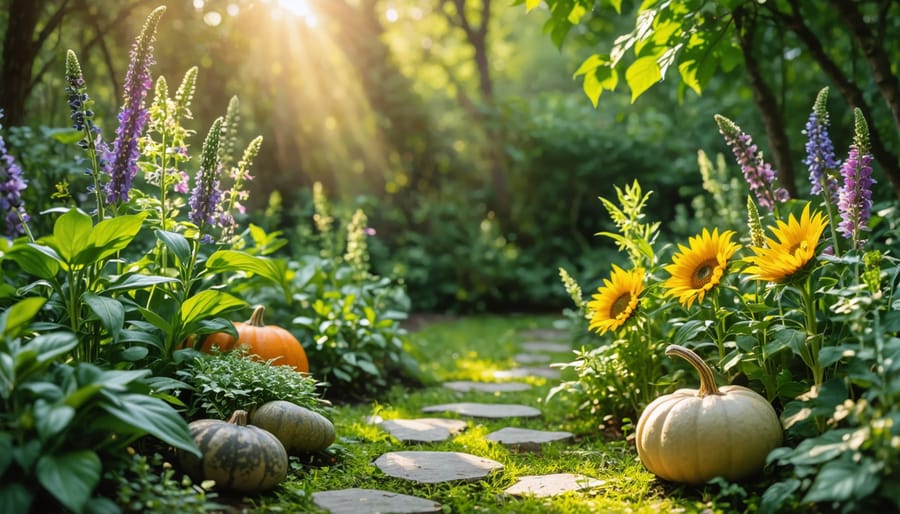Plant-Based Power: How Organic Seeds Balance Your Body’s Natural Hormones
Harness the power of naturally occurring plant hormones to revolutionize your health and wellness journey. From ancient medicinal traditions to modern scientific research, plant-based hormones offer a gentle yet effective approach to balancing our body’s complex endocrine system. These bioactive compounds, found abundantly in seeds, sprouts, and herbs, work synergistically with our bodies to support everything from stress management to reproductive health.
Unlike synthetic alternatives, plant-based hormones like phytoestrogens in flax seeds and adaptogenic compounds in holy basil provide balanced hormonal support without overwhelming the body’s natural regulatory systems. Recent studies have shown that these plant compounds can help manage menopausal symptoms, support thyroid function, and enhance overall hormonal balance through their unique ability to modulate hormone receptors.
Whether you’re looking to grow your own hormone-supporting herbs or incorporate more hormone-balancing foods into your daily routine, understanding the science behind plant-based hormones opens up a world of natural wellness possibilities. As more people seek natural alternatives to conventional hormone treatments, these powerful plant compounds offer a sustainable, accessible solution rooted in nature’s wisdom.
Understanding Plant-Based Hormones in Seeds
What Are Phytohormones?
Phytohormones are nature’s chemical messengers that regulate plant growth, development, and their natural defense mechanisms. Think of them as the conductors of a plant’s life orchestra, coordinating everything from seed germination to fruit ripening. These remarkable compounds include auxins, which drive stem growth; cytokinins, responsible for cell division; and gibberellins, which help seeds sprout and flowers bloom.
What makes phytohormones particularly fascinating is their ability to influence both plant and human health. When we consume organic produce rich in these natural hormones, we’re tapping into a wisdom that nature has perfected over millions of years. These compounds help plants adapt to environmental stresses, fight off pests, and maintain optimal growth patterns.
For gardeners and farmers, understanding phytohormones is key to nurturing healthy crops naturally. These chemical signals help plants develop strong roots, lush foliage, and abundant harvests without the need for synthetic hormones or growth regulators. By working with these natural plant hormones, we can create more resilient and sustainable food systems.

The Organic Advantage
Organic seeds pack a powerful punch when it comes to their hormone-supporting compounds. Unlike conventionally grown seeds, organic varieties are cultivated in nutrient-rich soil without synthetic pesticides or fertilizers, allowing them to develop their full spectrum of beneficial substances. This natural growing process enables plants to produce higher levels of protective compounds, including phytohormones that can offer significant metabolic health benefits.
When plants grow in organic conditions, they must naturally defend themselves against environmental stressors. This results in increased production of protective compounds like polyphenols, antioxidants, and beneficial plant hormones. These substances not only help the plant thrive but can also support our own hormonal balance when we consume them.
Research shows that organic seeds typically contain up to 25% more antioxidants and beneficial compounds compared to their conventional counterparts. This difference stems from the absence of synthetic pesticides, which can interfere with the plant’s natural defense mechanisms and hormone production. By choosing organic seeds, you’re not just avoiding unwanted chemicals – you’re actively selecting a more potent source of nature’s hormone-supporting nutrients.

Top Hormone-Balancing Seeds to Grow
Flax and Chia Seeds
Flax and chia seeds are powerhouse additions to any garden and diet, offering remarkable benefits for hormonal balance. These tiny seeds pack a significant punch of lignans and omega-3 fatty acids, which help support healthy estrogen levels and reduce inflammation in the body.
Growing flax is surprisingly straightforward in most climates. Plant seeds in early spring, spacing them about 6 inches apart in well-draining soil. The delicate blue flowers that appear before seed formation add a lovely touch to your garden. Flax prefers cool weather and needs consistent moisture but not waterlogged soil.
Chia plants, while traditionally grown in tropical regions, can thrive in container gardens or warm climates. These resilient plants produce attractive purple spikes and require minimal maintenance. Plant chia seeds after the last frost, keeping soil consistently moist until germination.
Harvesting both seeds requires patience and timing. For flax, wait until seed pods turn brown and rattle when shaken. Chia seeds are ready when flower heads dry and turn brown. To collect, cut entire seed heads and hang them upside down over a clean container.
For maximum hormonal benefits, consume 1-2 tablespoons of ground flax or chia seeds daily. Fresh-ground seeds offer the most potent benefits, so consider investing in a small grinder for daily use. Store whole seeds in an airtight container in the refrigerator to preserve their beneficial compounds.
Pumpkin and Sesame Seeds
Pumpkin and sesame seeds are powerhouse ingredients when it comes to supporting hormone balance naturally. These tiny nutritional gems pack a mighty punch, offering essential minerals and compounds that work in harmony with your body’s endocrine system.
Pumpkin seeds are particularly rich in zinc and magnesium, minerals crucial for maintaining healthy testosterone levels and supporting thyroid function. They also contain lignans, plant compounds that can help modulate estrogen levels in the body. For best results, consume raw, organic pumpkin seeds as a daily snack or sprinkled over salads and breakfast bowls.
Growing your own pumpkins for seeds is surprisingly straightforward. Plant them in full sun during spring, after the last frost, in well-draining soil enriched with compost. Each pumpkin can yield hundreds of seeds, making them an excellent investment for your garden and health.
Sesame seeds, despite their small size, are nutritional giants containing phytosterols that support hormone production. They’re especially rich in calcium and magnesium, minerals essential for hormone regulation. To maximize their benefits, try incorporating both black and white sesame varieties into your diet.
For home cultivation, sesame plants thrive in warm climates with temperatures between 70-80°F. While they require minimal maintenance, ensure proper spacing and consistent watering during the growing season. Harvest seeds when pods begin to crack naturally, typically 100-130 days after planting.
Sunflower and Hemp Seeds
Sunflowers and hemp plants are remarkable powerhouses of plant-based hormonal support, and the good news is that they’re relatively easy to grow in your own backyard! These resilient plants thrive in well-drained soil and full sunlight, making them perfect companions in your organic garden.
For sunflowers, plant seeds about 1-2 inches deep in spring after the last frost. Space them 6 inches apart for smaller varieties or up to 2 feet for giant varieties. The benefits of sunflower seeds include their rich content of vitamin E and selenium, which support hormone balance and thyroid function.
Hemp seeds require similar growing conditions but need more attention to soil preparation. Plant them about ½ inch deep in nutrient-rich, slightly alkaline soil. These seeds are packed with gamma-linolenic acid (GLA), which helps regulate hormonal balance, particularly during menstruation and menopause.
Both plants appreciate regular watering but are relatively drought-tolerant once established. Harvest sunflower seeds when the backs of the flower heads turn yellow-brown and the seeds are plump. Hemp seeds are ready for harvest when the seeds darken and begin to loosen from their shells.
Remember to save some seeds for next season’s planting – it’s a sustainable way to ensure a continuous supply of these hormone-supporting superfoods right from your garden!
Growing Your Hormone-Friendly Garden
Soil Preparation and Care
Preparing the right soil environment is crucial for growing hormone-rich plants successfully. Start by testing your soil’s pH level, aiming for a slightly acidic to neutral range (6.0-7.0), which helps optimize nutrient absorption. Most plants producing beneficial hormones thrive in well-draining, organic-rich soil.
Mix in high-quality compost to create a nutrient-dense growing medium. Add about 2-3 inches of organic matter and work it into the top 8-12 inches of soil. This enriches the soil with beneficial microorganisms that support plant growth and hormone production.
Consider incorporating natural amendments like kelp meal, which provides trace minerals and growth-promoting compounds. Bone meal adds phosphorus, essential for root development and hormone synthesis. A layer of mulch helps maintain consistent soil moisture and temperature, crucial factors for healthy hormone production in plants.
Avoid chemical fertilizers, as they can interfere with the natural hormone production process. Instead, maintain soil fertility through regular additions of compost tea or worm castings. These organic solutions provide slow-release nutrients that support sustained growth and optimal hormone levels.
Remember to rotate your crops annually to prevent soil depletion and maintain a healthy growing environment. This practice also helps manage pest pressure naturally, reducing the need for interventions that might affect plant hormone production.

Harvesting and Storage
Proper harvesting and storage techniques are crucial for maintaining the potency of plant-based hormones in your garden’s bounty. The best time to harvest most hormone-rich plants is early morning, just after the dew has dried but before the day’s heat sets in. This timing helps preserve the delicate compounds that make these plants so beneficial.
When collecting seeds, ensure they’re fully mature and dry on the plant. Gently remove them and store immediately in paper envelopes or breathable cloth bags – never plastic, as this can trap moisture and lead to mold growth. Some gardeners prefer to process their harvests into natural seed oils for longer shelf life and easier use.
Store your dried plants and seeds in a cool, dark place with consistent temperature, ideally between 32-41°F (0-5°C). A dedicated drawer in your refrigerator works well, but ensure your storage containers are airtight to prevent moisture absorption. Label everything with harvest dates and expected shelf life – most properly stored seeds maintain their hormonal properties for 1-2 years.
For fresh herbs and leaves, consider freeze-drying or air-drying methods to preserve their beneficial compounds. Hang bundles upside down in a well-ventilated area away from direct sunlight. Once completely dry, store in amber glass jars to protect from light degradation.
Regular quality checks are essential – examine stored materials monthly for any signs of moisture, mold, or pest activity. Replace your stock yearly to ensure maximum potency of plant hormones.
As we’ve explored throughout this article, creating your own hormone-balancing garden is both empowering and beneficial for your overall wellness. Nature has provided us with an incredible array of plants that can help support our hormonal health naturally, from adaptogenic herbs like holy basil to mineral-rich vegetables like kale and Swiss chard.
By growing these plants in your own garden, you’re not just cultivating food – you’re cultivating health. You have complete control over the growing conditions, ensuring your plants are free from harmful pesticides and grown in nutrient-rich soil. This direct connection to your food source also creates a deeper appreciation for the natural healing properties these plants provide.
Remember that starting small is perfectly fine. Even a few pots on your windowsill containing hormone-supporting herbs like sage and mint can make a difference. As your confidence grows, you can expand your garden to include more varieties of hormone-balancing plants.
The key to success lies in proper planning and patience. Choose plants that match your growing zone and available space, and don’t forget to incorporate a mix of different plants to support various aspects of hormonal health. Some plants will help with stress management, while others may support reproductive health or thyroid function.
Consider joining local gardening groups or online communities where you can share experiences and learn from others who are also growing their hormone-balancing gardens. These connections can provide valuable support and knowledge as you develop your green thumb.
As you embark on this journey, remember that every seed you plant is a step toward better hormonal health and a more sustainable lifestyle. Your garden will not only provide you with powerful plant-based hormones but also become a peaceful sanctuary where you can connect with nature and nurture your wellbeing.
Now is the perfect time to start planning your hormone-balancing garden. Whether you have acres of land or just a sunny windowsill, you can begin growing these beneficial plants and taking control of your hormonal health naturally.

